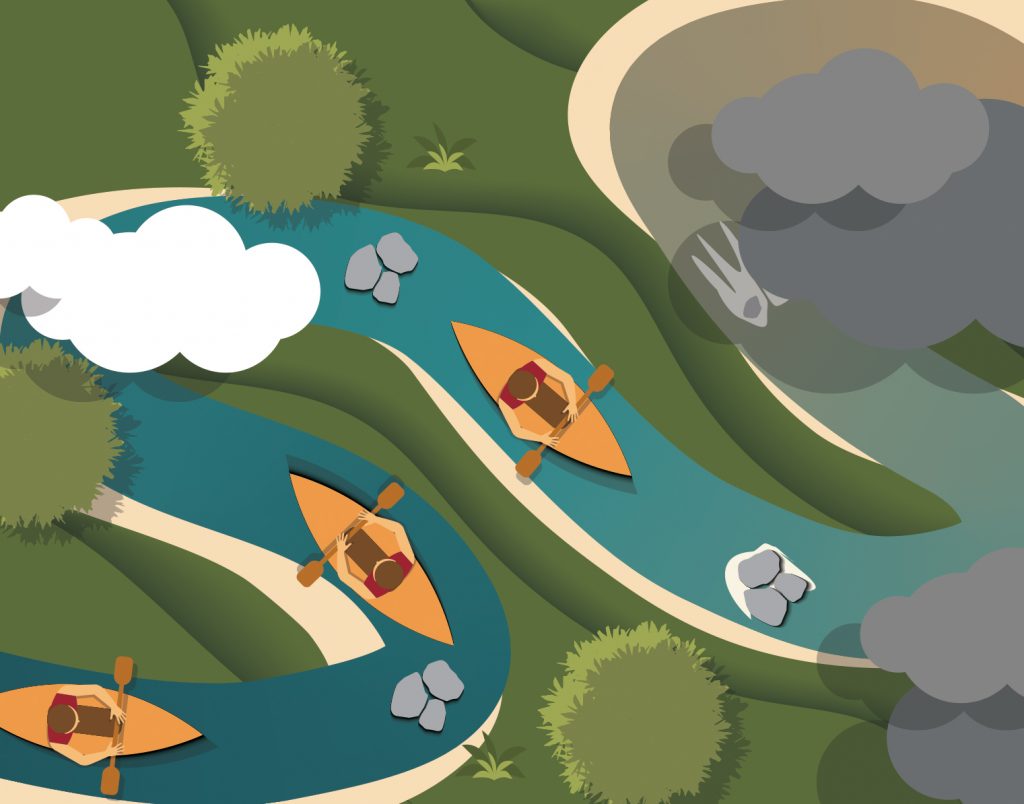BY JACK SPAULDING

Summertime brings kayakers and canoeists out to run the rivers and streams here in Indiana. Nothing is more fun than a leisurely trip down a river or stream, floating past the banks covered in wildflowers while bathing in the luxury and warmth of Mother Nature.
Among the beauty and tranquility, danger can lurk in the form of the rainstorms we experienced through this year’s wet spring and summer, or pop-up showers that can ignite any humid summer afternoon. Midwest storms can quickly drop 2 or 3 inches of rain. Even though there may have been no rain in the local area, storms farther up the watershed can send river and stream levels to dangerous levels within a few hours.
Heavy rains can turn even the most peaceful stream or river into a raging torrent producing Class 4 rapids and some of the most dangerous river conditions imaginable.
Downed trees called “sweepers” pose one of the greatest dangers. If the stream or river is blocked by a tree, the current can pull a boat or kayak into the limbs. This can turn the craft sideways of the flow causing it to capsize. Even if the occupants are wearing life jackets, the current might pull them into the limbs and hold them under water with no escape possible.
I have seen two channels of a river with the water roaring around an island. Where the two flows of water came back together and met, giant waves were formed which would flip a kayak and dump even the most skilled canoeists. What had been a peaceful waterway the day before had been quickly turned into a frightening out-of-control flow no one should consider entering.
Another relentless threat is a low-head dam where the water runs over the structure and produces a rolling underwater current at the base of the dam. A horrific current will grab a person and continually roll him or her back to the base of the dam and submerge the person … even if that person is wearing a life jacket. Chances of breaking free from the back current of a low-head dam with high water are slim or none.
To help stem the tide of water-related accidents, Indiana conservation officers have some suggestions. Regardless of why you are around bodies of water, you should always recognize the danger water poses, even to strong swimmers or experienced boaters. If you are going to be around water, please remember these basic safety tips:
• Always wear your life jacket.
• Always tell someone where you are going and when you will return.
• Go with a buddy.
• Never venture around flooded or fast moving waterways.
• Avoid alcohol.
My advice: If you come to a stream or river and the water is brown … turn around. Brown, murky water is a sure sign the river or stream is flowing at higher than its normal rate and may present unimaginable downstream dangers.
If you still want to enjoy some time in your kayak or canoe, I suggest heading to one of the lakes or reservoirs in one of our state parks and do some leisurely paddling. And always (ALWAYS!) wear a life jacket. My good friend and retired conservation office Monte Beaver once said, “I’ve never seen a drowning victim wearing a life jacket.”
‘til next time.
JACK SPAULDING is a state outdoors writer and a consumer of RushShelby Energy living along the Flatrock River in Moscow. Readers with questions or comments can write to him in care of Indiana Connection or email jackspaulding@hughes.net.



